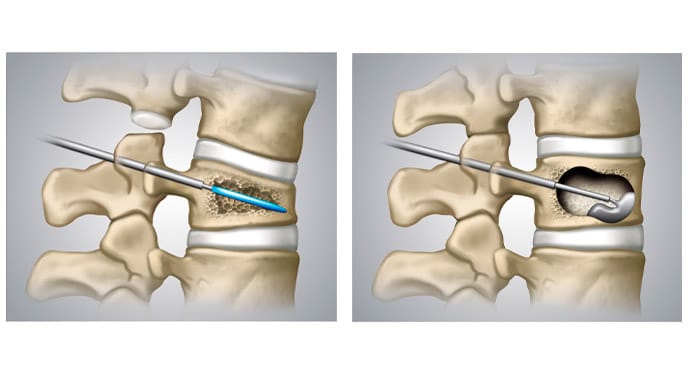Indications
Vertebral cement augmentation is indicated for patients with:
- Painful vertebral compression fractures due to osteoporosis, trauma, or cancer
- Persistent pain despite conservative treatment, such as pain medications and bracing
- Vertebral height loss leading to spinal deformity or instability
- In some cases, prophylactic treatment of at-risk vertebrae
Techniques
A. VERTEBROPLASTY:
- A hollow needle, called a trocar, is inserted through the skin and directed into the fractured vertebral body under fluoroscopic guidance.
- Bone cement (polymethylmethacrylate or PMMA) is injected through the trocar, filling the vertebral body's voids and cracks.
- The cement hardens within minutes, stabilizing the fracture and alleviating pain.
B. KYPHOPLASTY:
- Similar to vertebroplasty, a trocar is inserted into the fractured vertebral body under fluoroscopic guidance.
- Instead of injecting cement immediately, an inflatable balloon is inserted and inflated, creating a cavity within the vertebral body and restoring some of the lost vertebral height.
- The balloon is then deflated and removed, and bone cement is injected into the cavity to stabilise the fracture.
Benefits
- Pain relief: Vertebroplasty and kyphoplasty often provide rapid and significant pain relief within hours or days.
- Minimally invasive: These procedures involve small incisions, have fewer complications, and have shorter recovery times than open surgery.
- Improved function: Pain reduction allows patients to engage in physical therapy and return to daily activities more quickly.
- Vertebral stabilization: Cement augmentation stabilizes the fractured vertebra, reducing the risk of further collapse or deformity.
- Prophylactic treatment: In some cases, vertebral cement augmentation can be used to treat vertebrae at risk of fracture, preventing future fractures and deformities.
Risks
Despite their benefits, vertebral cement augmentation procedures carry potential risks, including:
- Infection or bleeding at the insertion site
- Cement leakage into surrounding tissues, veins, or spinal canal, potentially causing nerve damage or blood clots
- Allergic reactions to anesthesia or bone cement
- Adjacent vertebral fractures due to increased pressure on neighboring vertebrae
- In rare cases, pulmonary embolism or cement embolism
Patient Selection and Precautions
Not all patients with spinal fractures are suitable candidates for vertebral cement augmentation. Ideal candidates have:
- Recent, painful fractures with minimal vertebral height loss
- Failed conservative treatment
- No contraindications, such as infection or severe spinal canal narrowing Before the procedure, a thorough evaluation, including medical history, physical examination, and imaging studies, is essential to determine the most appropriate treatment option.
Vertebral cement augmentation, including vertebroplasty and kyphoplasty, is a minimally invasive, effective treatment for painful vertebral compression fractures.
These procedures offer significant pain relief, improved function, and vertebral stabilization.
Although generally safe, patients should consider potential risks and benefits to determine if Cement Augmentation is right for you.
